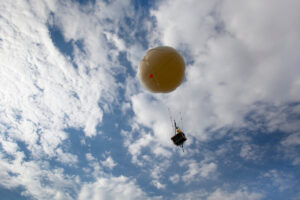Aviation weather reports made easier with Status ADS-B
The Stratus ADS-B receiver has become the most popular aviation weather receiver for the iPad, and for good reason: it is incredibly simple to use. Just turn it on and within minutes you will see subscription free weather, ADS-B traffic, backup attitude, and GPS position on your tablet.
The latest generation is the Stratus 3 and is able to receive new ADS-B products – pilots can now view echo tops, lightning, icing forecasts, turbulence forecasts, Center Weather Advisories and G-AIRMETs. All at your fingertips!
Even though the basic operation is simple, there are a few things you should be aware of to get the most out of your Stratus.
Placement
Performance can be affected by where you choose to place the unit. The ideal location includes these four things:
- A view of the sky to receive GPS signals
- A view to the ground to receive ADS-B signals
- A relatively stable place for the AHRS
- An area out of the sun with ventilation to prevent overheating
Information
Stratus has a status page that contains a wealth of information. To find it, go to the Maps page on Foreflight, tap the “settings” button and then tap Stratus at the bottom. You will be brought to a page that includes a lot of Stratus information, including battery level, age of weather, ground station reception, GPS status and more. Need to troubleshoot? This is the page to do it.
Weather
When you need to deviate around weather, use the rubber band flight plan method to modify your route of flight in a way that ATC will know exactly where you want to go. Simply tap and hold your course line and then drag it until your course will clear the weather. When you release the line, a list of suggested waypoints will appear, so you can formulate a plan with ATC.
It is also critical to watch the time stamp for your weather data. This is always located on the top left corner of the Maps page and if you tap on it, it will give you a detailed report. You will be able to see the time you received your last report for all of the layers you have turned on (radar, traffic, TFR’s etc). You should usually see a timestamp within the last 5 – 15 minutes – if it ever gets above 30 minutes, you may have a problem.
Tracking
There is a track vector function that is extremely helpful when your heading and your track don’t match up. Turning on the track vector (in Foreflight’s setting page) when deviating around weather will draw a blue line in the direction you are actually traveling over the ground. This will make it crystal clear if your chosen heading will clear the upcoming weather.
Stratus does a great job of displaying the aviation weather and also giving you the tools necessary to safely navigate around the weather. With a little practice and experimentation, you can learn how to get the most of your investment. It will be well worth the effort!
RELATED READING
RELATED CTS TRAINING










